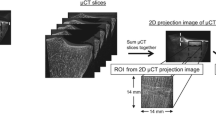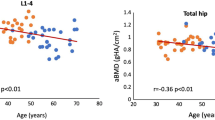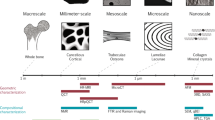Abstract
In osteoporosis, bone fragility results from both bone loss and changes in trabecular microarchitecture, which can be quantified by bone histomorphometric parameters. Twenty human calcaneum were collected after necropsy. All measurements were performed at the same anatomical location. Bone histomorphometric parameters were measured on histological slides with an automatic image analyzer. The aims of our study were (1) to develop automatic measurements of four additional parameters reflecting trabecular network connectivity and complexity, i.e., trabecular bone pattern factor (TBPf), Euler number/tissue volume (Euler) according to the three definitions previously reported and to a fourth one established in the laboratory (Euler strut.cavity ), marrow star volume, and interconnectivity index, and to determine their usefulness in microarchitecture characterization; and (2) to validate these parameters by evaluating their relationship with dual-energy X-ray absorptiometry and quantitative ultrasound (QUS) measurements performed on the same samples. The statistical analysis showed that TBPf and Euler strut.cavity appeared to be the most significant connectivity parameters, independently of bone quantity (bone mineral density, apparent density, cancellous bone volume). For QUS, after adjustment for bone quantity, only speed of sound (SOS) was significantly and negatively correlated to Euler strut.cavity . Broadband ultrasound attenuation depends only on bone quantity. In conclusion, TBPf (a strut analysis parameter extrapolable in three dimensions) and Euler strut.cavity (the only bone connectivity parameter reflecting SOS) are two valid bone microarchitecture parameters. These new parameters were significantly correlated to the established trabecular structure parameters: trabecular thickness or trabecular spacing, being weakly correlated with SOS.





Similar content being viewed by others
References
Leichter I, Margulies JY, Weinreb A, Mizrahi J, Robin GC, Conforty B, Makin M, Bloch B (1982) The relationship between bone density, mineral content, and mechanical strength in the femoral neck. Clin Orthop Relat Res 163:272–281
Ammann P, Rizzoli R (2003) Bone strength and its determinants. Osteoporos Int 14:13–18
Follet H, Boivin G, Rumelhart C, Meunier PJ (2004) The degree of mineralization is a determinant of bone strength: a study on human calcanei. Bone 34:783–789
Chavassieux P, Arlot M, Meunier PJ (2001) Clinical use of bone biopsy. In: Marcus R, Feldman D, Kelsey J (eds), Osteoporosis, 2nd ed. Academic Press, San Diego, pp 501–509
Hahn M, Vogel M, Pompesius-Kempa M, Delling G (1992) Trabecular bone pattern factor – a new parameter for simple quantification of bone microarchitecture. Bone 13:327–330
Coster M, Chermant JL (1989) Précis d’analyse d’images. Presses du CNRS, Paris, pp 22–27
Croucher PI, Garrahan NJ, Compston JE (1996) Assessment of cancellous bone structure: comparison of strut analysis, trabecular bone pattern factor and marrow space star volume. J Bone Miner Res 11:955–961
Le Ha M, Holmes RE, Shors EC, Rosenstein DA (1992) Computerized quantitative analysis of the interconnectivity of porous biomaterials. Acta Stereol 11(suppl I):267–272
Hans D, Arlot ME, Schott AM, Roux JP, Kotzki PO, Meunier PJ (1995) Do ultrasound measurements on the os calcis reflect more the bone microarchitecture than the bone mass? A two-dimensional histomorphometric study. Bone 16:295–300
Kaufman JJ, Einhorn TA (1993) Ultrasound assessment of bone. J Bone Miner Res 8:517–525
Njeh CF, Hans D, Wu C, Kantorovich E, Sister M, Fuerst T, Genant HK (1999) An in vitro investigation of the dependence on sample thickness of the speed of sound along the specimen. Med Eng Phys 21:651–659
Njeh CF, Saeed I, Grigorian M, Kendler DL, Fan B, Shepherd J, McClung M, Drake WM, Genant HK (2001) Assessment of bone status using speed of sound at multiple anatompical sites. Ultrasound Med Biol 27:1337–1345
Nicholson PHF, Bouxsein ML (2002) Bone marrow influences quantitative ultrasound measurements. I Human cancellous bone. Ultrasound Med Biol 28:369–375
Njeh CF, Fuerst T, Diessel E, Genant HK (2001) Is quantitative ultrasound dependent on bone structure? A reflection. Osteoporos Int 12:1–15
Nicholson PHF, Müller R, Cheng XG, Rüegsegger P, Van Der Perre G, Dequeker J, Boonen S (2001) Quantitative ultrasound and trabecular architecture in the human calcaneus. J Bone Miner Res 16:1886–1892
Cheng S, Njeh CF, Fan B, Cheng X, Hans D, Wang L, Fuerts T, Genant HK (2002) Influence of region of interest and bone size on calcaneal BMD: implications for the accuracy of quantitative ultrasound assessments at the calcaneus. Br J Radiol 75:59–68
Bruce MR, Sharkey NA (2001) Mechanical effects of postmortem changes, preservation, and allograft bone treatments. In: Cowin SC (ed), Bone mechanics handbook, 2nd ed. CRC Press, Boca Raton, pp 20–24
Genant HK, Engelke K, Fuerst T, Glüer CC, Grampp S, Harris ST, Jergas M, Lang T, Lu Y, Majumdar S, Mathur A, Takada M (1996) Noninvasive assessment of bone mineral and structure: state of the art. J Bone Miner Res 11:707–730
Kang C, Paley M, Ordidge R, Speller R (1999) In vivo MRI measurements of bone quality in the calcaneus: a comparison with DXA and ultrasound. Osteoporos Int 9:65–74
Szucs J, Jonson R, Granhed H, Hansson T (1992) Accuracy, precision and homogeneity effects in the determination of the bone mineral content with dual photon absorptiomery in the heel bone. Bone 13:179–183
Hans D (1993) Validation des mesures ultrasoniques sur le calcanéum. Application à la physiologie des ostéoporoses [thesis]. Université Claude Bernard, Lyon, France
Gonnelli S, Cepollaro C, Montagnani A, Martini S, Gennari L, Mangeri M, Gennari C (2002) Heel ultrasonography in monitoring alendronate therapy: a four-year longitudinal study. Osteoporos Int 13:415–421
Meunier PJ (1983) Histomorphometry of the skeleton. In: Peck WA (ed), Bone and mineral research annual. A year of developments in the field of bone and mineral metabolism. Excerpta Medica, Amsterdam, pp 191–222
Parfitt AM, Drezner MK, Glorieux FH, Kanis JA, Malluche H, Meunier PJ, Ott SM, Recker RR (1987) Bone histomorphometry: standardization of nomenclature, symbols and units. J Bone Miner Res 2:595–610
Parfitt A, Mathews CHE, Villanueva AR, Kleerekoper M, Frame B, Rao DS (1983) Relationships between surface, volume and thickness of iliac trabecular bone in aging and in osteoporosis: implications for the microanatomic and cellular mechanisms of bone loss. J Clin Invest 72:1396–1409
Garrahan NJ, Mellish RWE, Compston JE (1986) A new method for the two-dimensional analysis of bone structure in human iliac crest biopsies. J Microsc 142:341–349
Mellish RWE, Ferguson-Pell MW, Cochran GVB, Lindsay R, Dempster DW (1991) A new manual method for assessing two-dimensional cancellous bone structure: comparison between iliac crest and lumbar vertebra. J Bone Miner Res 6:689–696
Feldkamp LA, Goldstein SA, Parfitt AM, Jesion G, Kleerekoper M (1989) The direct examination of three-dimensional bone architecture in vitro by computed tomography. J Bone Miner Res 4:3–11
Chappard D, Legrand E, Baslé MF, Audran M (1997) Measuring trabecular bone architecture by image analysis of histological sections. Eur Microsc Anal 50:13–1530
Compston JE (1994) Connectivity of cancellous bone: assessment and mechanical implications. Bone 15:463–466
Odgaard A (1997) Three-dimensional methods for quantification of cancellous bone architecture. Bone 20:315–328
Vesterby A, Gundersen HJG, Melsen F (1989) Star volume of marrow space and trabeculae of the first lumbar vertebra: sampling efficiency and biological variation. Bone 10:7–13
Levitz P, Tchoubar D (1992) Disorded porous solids: from chord distributions to small angle scattering. J Phys I, France 2:771–790
Chappard D, Legrand E, Baslé MF, Fromont P, Racineux JL, Rebel A, Audran M (1996) Altered trabecular architecture induced by corticosteroids: a bone histomorphometric study. J Bone Miner Res 11:676–685
Vogel JM, Wasnich RD, Ross PD (1988) The clinical relevance of calcaneus bone mineral measurements: a review. Bone Miner 5:35–58
Flautre B, Hardouin P (1994) Microradiographic aspect on iliac bone tissue in postmenopausal women with and without vertebral crush fractures. Bone 15:477–481
Libouban H, Moreau MF, Legrand E, Audran M, Baslé MF, Chappard D (2002) Comparison of histomorphometric descriptors of bone architecture with dual-energy X-ray absorptiometry for assessing bone loss in the orchidectomized rat. Osteoporos Int 13:422–428
Glüer CC, Wu CY, Jergas M, Goldstein SA, Genant HK (1994) Three quantitative ultrasound parameters reflect bone structure. Calcif Tissue Int 55:46–52
Trebacz H, Natali A (1999). Ultrasound velocity and attenuation in cancellous bone samples from lumbar vertebra and calcaneus. Osteoporos Int 9:99–105
Tribl B, Vogelsang H, Pohanka E, Grampp S, Gangl A, Hörl WH (1998) Broadband ultrasound attenuation of the calcaneus – a tool for assessing bone status in patients with chronic renal failure. Acta Radiol 39:637–641
Häusler KD, Rich PA, Smith PC, Barry EB (1999) Relationships between static histomorphometry and ultrasound in the human calcaneuus. Calcif Tissue Int 64:477–480
Hans D, Wu C, Njeh F, Zhao S, Augat P, Newitt D, Link T, Lu Y, Majumdar S, Genant HK (1999) Ultrasound velocity of trabecular cubes reflects mainly bone density and elasticity. Calcif Tissue Int 64:18–23
Follet H, Bruyère-Garnier F, Peyrin F, Roux JP, Arlot ME, Burt-Pichat B, Rumelhart C, Meunier PJ (2005) Relationship between compressive properties of human os calcis cancellous bone and microarchitecture assessed from 2D and 3D synchrotron microtomography. Bone 36:340–351
Author information
Authors and Affiliations
Corresponding author
Rights and permissions
About this article
Cite this article
Portero, N.R., Arlot, M.E., Roux, JP. et al. Evaluation and Development of Automatic Two-Dimensional Measurements of Histomorphometric Parameters Reflecting Trabecular Bone Connectivity: Correlations with Dual-Energy X-Ray Absorptiometry and Quantitative Ultrasound in Human Calcaneum. Calcif Tissue Int 77, 195–204 (2005). https://doi.org/10.1007/s00223-004-1260-0
Received:
Accepted:
Published:
Issue Date:
DOI: https://doi.org/10.1007/s00223-004-1260-0




